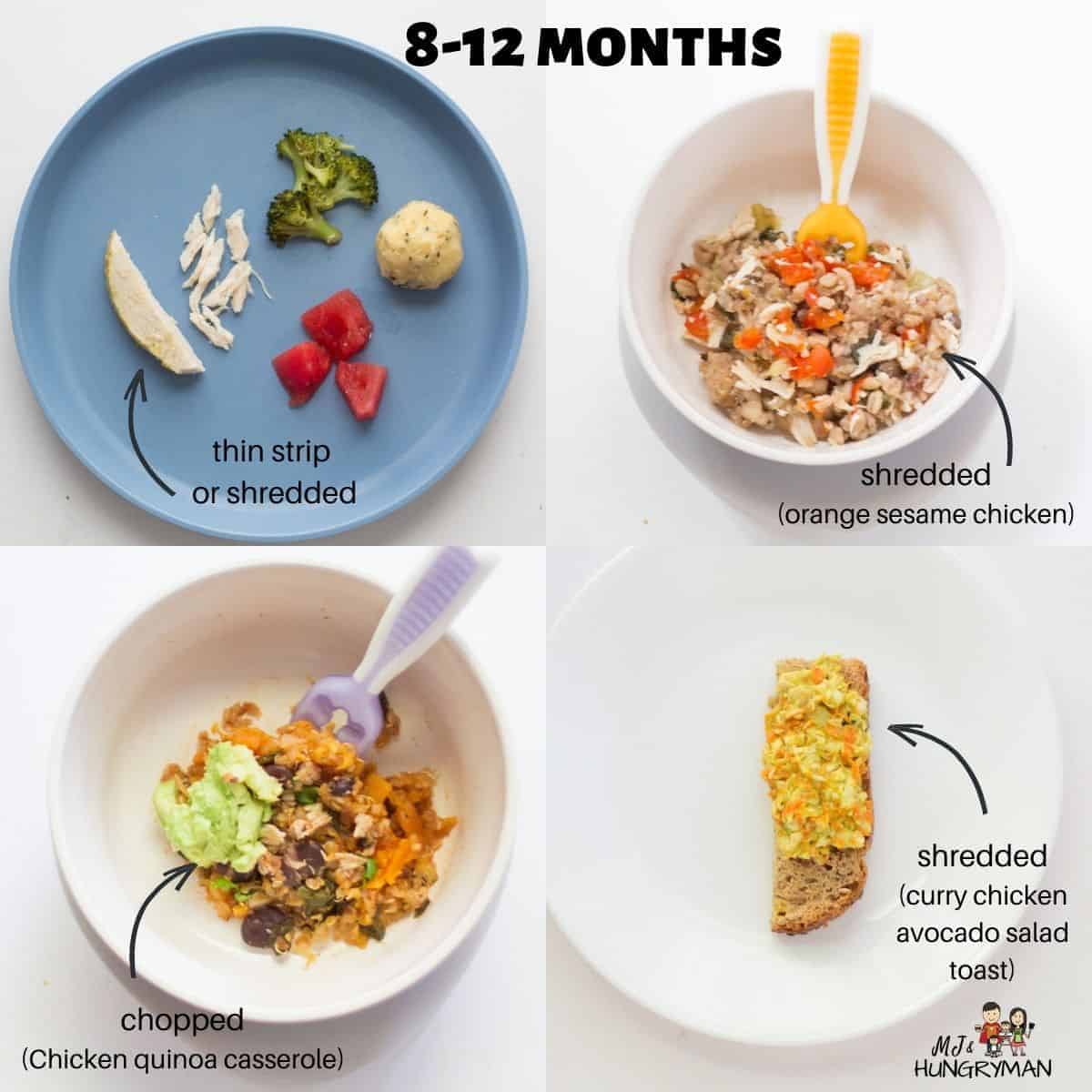When to introduce
Chicken can be offered to babies as soon as they’re ready to start solids, usually around 6 months. It’s important to remember that your baby is unique and that rather than going by the calendar, you need to make sure your baby is DEVELOPMENTALLY ready to start solids. If you’re unsure, be sure to grab my FREE handout!
Health benefits
Just like with beef, chicken is an excellent source of iron, arguably THE most important nutrient for babies. It’s also a great source of (highlighting a few):
Zinc – Necessary for making protein and DNA, aids in immune function and cognition Choline, vitamins B6 and B12 – Important for optimal brain development, metabolism and maintaining a healthy nervous system. High-quality protein – Chicken contains all the essential amino acids, or building blocks, of protein that are necessary for our babies to grow and thrive!
Is chicken safe for babies?
First, I want to reassure you that babies do NOT need teeth to eat meat or any other finger food for that matter. You’ll be amazed by how strong and capable their gums are! Will your baby gag? Most likely, just like with any food, even purées! And this is actually a good thing! I discuss more in this post – how to start baby led weaning. However, you need to make sure chicken is cooked properly and served in an age-appropriate way. I highly encourage you to Invest in a good meat thermometer so you can check the internal temperature for not only chicken but any meat/poultry. Chicken is safe to eat when its juices run clear, the inside is no longer pink (although sometimes it can still have a pinkish tint), and the thickest part of the meat reaches at least 165° Fahrenheit. How to serve the right size and texture
Top 4 Cooking Methods
Here are the top ways to prepare chicken, including the cooking times. I am specifically showing you how to cook chicken breast, as it is the most difficult cut to cook properly. Say no more to dry, tough meat.
Poaching
In a pot, place the chicken breasts in a single layer. Cover with water or broth. You can add some herbs or a bay leaf. Bring to a boil, then quickly reduce heat to low, cover, and simmer for 10-15 minutes. Make sure the thickest part of the meat reads 165°F.
Roasting (with a twist!)
Juicy, tender, flavorful chicken breast – here we go! If you haven’t tried steam roasting yet, you MUST! Here’s an in-depth explanation of this cooking method. It’s seriously the BEST way to cook meat/poultry and vegetables for babies and toddlers! Not only will it save you time and energy but it will also result in that perfectly safe texture for babies. Another big advantage of this method is that you can season your chicken for extra flavor before putting it in the oven. I actually prefer this over poaching. Simply add the chicken (seasoned or not) to a baking dish, cover, and allow for it to bake in its own juices!
Marinate with yogurt
I know it may sound strange BUT this method of cooking is AH-MAZING! Be sure to give it a try!
Instant Pot or Pressure Cooker
Add water to the IP, insert trivet, and add chicken. Cook on high pressure for 8-10 minutes. Once it beeps, wait 5 minutes then release pressure.
How to Serve for Baby Led Weaning
Cook the chicken using any of the methods above or try my recipes that your ENTIRE family can enjoy together (sharing below). Then make modifications according to your baby’s age.
6-8 months baby
Chicken puree – Cook chicken and blend with broth, water, or breastmilk. Serve on its own or mixed with veggies. And don’t forget to add seasonings. Do keep in mind, it’s important to move forward with texture by 9 months at the latest. Here’s how to transition baby from puree to table food. Serve as a finger food – Big strips (1-2 inch wide), drumstick, a whole meatball are all great! I know this might sound counterintuitive, BUT bigger is better and safer for this age! Your baby will grab with their palm and suck on the juices, which is wonderful! Your baby is getting exposed to flavor, texture, and iron. These are my top meatball recipes. You can easily substitute with ground chicken
Asian Turkey Rice Meatballs Butternut squash baby beef meatballs Baked quinoa and mushroom meatballs Turkey beet meatballs
Finely chopped/minced – If you are anxious about serving a large piece, then go really small. You can do this by hand or I like to use this mini manual food chopper! And then the sky’s the limit! Add to oatmeal, lentils, pasta, mashed avocado, etc.
8-12 months old baby
Once your baby is able to tear or break off a large chunk of meat, it is no longer safe. Go smaller by serving thinner strips (about the size of your pinky finger) or shred.
12+ months
At this age, you can cut into bite-sized pieces, making sure they are not cubed. Also, encourage the use of utensils by providing them with plenty of opportunities to practice. Be consistent and patient as it’s a skill that takes a while to master.
Chicken Recipes for Baby
Here are some baby-friendly dishes that the entire family can enjoy together! Once cooked, modify the chicken by following the serving suggestions according to your baby’s age as mentioned above.
Instant Pot peanut chicken Chicken quinoa spinach casserole Instant Pot Korean chicken and potatoes Orange sesame chicken with vegetables curry chicken avocado salad Low sodium moo goo gai pan
There are more recipes in my cookbooks.
Additional Resource
Are you:
getting ready to start or at the beginning stage of introducing solid solids and feeling overwhelmed? stuck on purees and having a really difficult time transitioning to table food? or tired of serving the same foods on repeat and want to offer more variety of foods to your older baby or toddler?
Here’s my 3 MONTH Baby Led Feeding Journey Program! It’s a complete roadmap that would show you through daily videos and photos of what foods and how to serve them to your baby AND the rest of the family at the same time. Everything you need to know all in one place! Did you make this recipe? Leave a rating below and let me know how you liked the recipe! Your feedback means so much to me!










